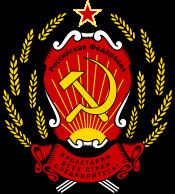Signed 23 May 1992 Effective 5 December 1994 | ||
 | ||
Signatories | ||
The john galt brigade historical context lisbon protocol
The Lisbon Protocol to the 1991 Strategic Arms Reduction Treaty was an agreement by representatives of Russia, Belarus, Ukraine, and Kazakhstan that all nuclear weapons of the former Soviet Union on the soil of those four states would be destroyed or transferred to the control of Russia. All four states agreed to join the Treaty on the Non-Proliferation of Nuclear Weapons, with Russia the successor to the Soviet Union as a nuclear state, and the other three states joining as non-nuclear states. The protocol was signed in Lisbon, Portugal, on May 23, 1992.
Contents
Background
When the Soviet Union dissolved in December 1991, one of the issues was the fate of its nuclear weapons. Most were in the territory of Russia, the recognized successor state to the Soviet Union, but some were in the territories of Belarus, Ukraine, and Kazakhstan. In July 1991, the Soviet Union had signed the START I nuclear disarmament treaty. Russia, as the successor state, would not be able to fulfill the terms of the treaty until all of the other states possessing Soviet nuclear weapons had either destroyed those weapons or transferred them to Russian control. The United States and Russia applied diplomatic pressure to the other three Soviet successor nuclear states to agree to eliminate their arsenals or transfer them to Russian control.
Implementation
Although Belarus, Ukraine, and Kazakhstan had signed the protocol in May 1992, each state had to ratify and implement the protocol. In Belarus and Ukraine, there was some resistance to giving up nuclear arms. However, on December 5, 1994, all signatories to the Lisbon Protocol exchanged instruments of ratification, and the agreement came into force. At this time, Russia was also able to ratify START I as the successor state to the Soviet Union.
Kazakhstan's government was more interested in focusing resources on the country's development rather than on maintenance of a nuclear arsenal. In return for security guarantees, military aid, and financial assistance and compensation from the United States and Russia, Kazakhstan had surrendered all nuclear weapons to Russia by May 1995. Both Belarus and Ukraine resisted full implementation of the protocol during the 1990s, wishing to retain a nuclear deterrent force or a diplomatic bargaining chip. However, Belarus was economically dependent on Russia and eventually carried out its agreement to transfer all nuclear weapons to Russia. Like Kazakhstan, Ukraine eventually agreed to surrender its nuclear weapons in exchange for security guarantees, military aid, financial assistance, and compensation from the United States and Russia. Implementation of the Lisbon Protocol was complete when both Belarus and Ukraine had surrendered their nuclear weapons to Russia by the end of 1996.
